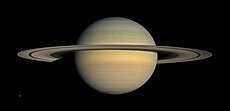Solar System (Teleon)
This article is incomplete because it is pending further input from participants, or it is a work-in-progress by one author. Please comment on this article's talk page to share your input, comments and questions. Note: To contribute to this article, you may need to seek help from the author(s) of this page. |
| Age | 4.568 billion years |
|---|---|
| Location | Local Interstellar Cloud Local Bubble X X |
| Nearest star | Cygnus Coronae (4,1405 ly) |
| Planetary system | |
| Semi-major axis of outer planet (X) | 30.06 AU |
| Distance to Kuiper cliff | 55–60 AU |
Populations | |
| Stars | Sun |
| Planets |
|
| Known dwarf planets |
|
| Known natural satellites | 694 |
| Known minor planets | ~1.482 million |
| Known comets | 4,663 |
| Orbit about Galactic Center | |
| Invariable-to-galactic plane inclination | ~60°, to the ecliptic |
| Distance to Galactic Center | 21,000–23,500 ly |
| Orbital speed | 745,000 km/h (462,000 mi/h) |
| Orbital period | ~205 million years |
| Star-related properties | |
| Spectral type | G2V |
| Frost line | ~5 AU |
| Distance to heliopause | 121 AU |
| Hill sphere radius | 1.1 pc |
The Solar System is the gravitationally bound system of the Sun and the objects that orbit it.
Sun
Inner Solar System
The inner Solar System comprise the four terrestrial planets, made up of refractory materials such as silicates and metals which from the planets' respective crusts and mantles, as well as one gas giant consisting mainly of gasses such as hydrogen and helium. The boundary of this region is scientifically arbitrary as there is no system feature that denotes an exact border, though all planets of the inner SOlar System have substantial atmospheres, no ring systems, few to no moons and are all located within the system's frost line.
Laophanes

Laophanes is the closest planet to the Sun and the third-largest planet of the system (approximately 17 M🜨) due to it being a gas giant. The planet has no natural satellites, but a noticably short orbital period of 24 days which warranted the current classification of Laophanes as a hot Iphias, as well as a retrograde orbit. Due to its proximity to the Sun, it remains tidally locked with the planetary day side experiencing high stellar irradiation and a temperature difference of some 500 K in comparison to its night side. This environment allows for intense wind currents, radical atmospheric stratification and super-rotating equatorial jet streams and storm vortices. Laophanes' origin and history have not yet been explained, though the planetary migration hypothesis is generally ruled to be the most likely one. It is probable Laophanes will eventually be stripped bare of its atmosphere due to hydrodynamic escape and become a chthonian planet some 2.3 billion years in the future.
Maciune
Maciune is the smallest planet in the Solar System, with less than 0.096 M🜨, and the second-closest planet to the Sun. It is characterized by its unusually large axial tilt at almost 79.2 degrees, the highest orbital eccentricity of any planet in the system, and the striking outside resemblence to Luna; Maciune features a heavily cratered and rugged surface, indicating long-subsided geological activity. However, long and prominent streaks of material traversing the planet's surface, called lineae (meaning "lines"), potentially indicate tectonic activity analogous to mid-ocean ridges on Teleon and, ultimately, tidal flexing in the planet's distant past. Therefore, Maciune is generally agreed to have been a former and escaped moon of Laophanes, knocked out of its orbit at some point during Laophanes' migration phase. Because it is tectonically dormant and relatively small, it retains only a very faint surface-bound exosphere incapable of a greenhouse effect and therefore sees temperature fluctations in the range of 600 K (327 °C; 620 °F).
Teleon
Teleon, or Earth, is the third-closest planet to the Sun and the second-largest and single largest terrestrial planet in the entire and inner system respectively. It is special in that it is the only known celestial body to exhibit developed life, a liquid hydrosphere and active plate tectonic activity. Composed of a solid inner core, a liquid outer core and mantle, and a solid crust through planetary differentiation, Teleon also simultaneously is the most dense terrestrial planet and possesses the largest terrestrial geomagnetic field. The presence of life radically altered the planet's atmospheric makeup through the emission of most notably oxygen, carbon dioxide and methane, surface through vegetation and human activities, and the consumption of its natural resources. Teleon is part of a binary planet system together with its only natural satellite, Luna or the Moon, which also is the only large satellite of a terrestrial planet in the Solar System.
Luna
Luna, or the Moon, is the only natural satellite of Teleon. With approximately two-thirds the diameter and one quarter the mass of Teleon (0.27 M🜨), Luna, as a planetary-mass object, is considered to be the binary planetary partner to Teleon, and its gravitational influence so large that the barycenter of the Teleon system lies outside Teleon, causes Teleon's tides and is responsible for its tidal acceleration, as is vice versa the case for Luna due to Teleon's gravity. It lacks any noteworthy magnetic field, atmosphere or hydrosphere, and features dark maria ("seas") of volcanic origin, impact craters, lobed rupes ("cliffs") and highly variable topography. Its origin and interior are not fully understood, as its core is disproportionally large and its formation can only partly be explained by the proposed giant-impact hypothesis, gravitational capture of Luna, or joint formation of Teleon and Luna in a circumplanetary disk.
X
X TBD
Outer Solar System
Iphias
Iphias TBD
Asteroid belt
The asteroid belt TBD
Atiner
Atiner TBD
X
X TBD


